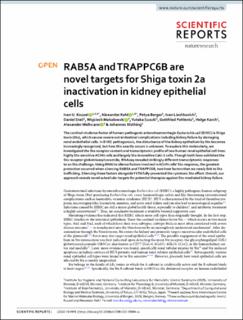| dc.contributor.author | Kouzel, Ivan | |
| dc.contributor.author | Kehl, Alexander | |
| dc.contributor.author | Berger, Petya | |
| dc.contributor.author | Liashkovich, Ivan | |
| dc.contributor.author | Steil, Daniel | |
| dc.contributor.author | Makalowski, Wojciech | |
| dc.contributor.author | Suzuki, Yutaka | |
| dc.contributor.author | Pohlentz, Gottfried | |
| dc.contributor.author | Karch, Helge | |
| dc.contributor.author | Mellmann, Alexander C. | |
| dc.contributor.author | Müthing, Johannes | |
| dc.date.accessioned | 2021-06-15T12:32:18Z | |
| dc.date.available | 2021-06-15T12:32:18Z | |
| dc.date.created | 2021-01-27T12:39:53Z | |
| dc.date.issued | 2020-03-18 | |
| dc.Published | Scientific Reports. 2020, 10 (1), . | |
| dc.identifier.issn | 2045-2322 | |
| dc.identifier.uri | https://hdl.handle.net/11250/2759569 | |
| dc.description.abstract | The cardinal virulence factor of human-pathogenic enterohaemorrhagic Escherichia coli (EHEC) is Shiga toxin (Stx), which causes severe extraintestinal complications including kidney failure by damaging renal endothelial cells. In EHEC pathogenesis, the disturbance of the kidney epithelium by Stx becomes increasingly recognised, but how this exactly occurs is unknown. To explore this molecularly, we investigated the Stx receptor content and transcriptomic profile of two human renal epithelial cell lines: highly Stx-sensitive ACHN cells and largely Stx-insensitive Caki-2 cells. Though both lines exhibited the Stx receptor globotriaosylceramide, RNAseq revealed strikingly different transcriptomic responses to an Stx challenge. Using RNAi to silence factors involved in ACHN cells’ Stx response, the greatest protection occurred when silencing RAB5A and TRAPPC6B, two host factors that we newly link to Stx trafficking. Silencing these factors alongside YKT6 fully prevented the cytotoxic Stx effect. Overall, our approach reveals novel subcellular targets for potential therapies against Stx-mediated kidney failure. | en_US |
| dc.language.iso | eng | en_US |
| dc.publisher | Nature Research | en_US |
| dc.rights | Navngivelse 4.0 Internasjonal | * |
| dc.rights.uri | http://creativecommons.org/licenses/by/4.0/deed.no | * |
| dc.title | RAB5A and TRAPPC6B are novel targets for Shiga toxin 2a inactivation in kidney epithelial cells | en_US |
| dc.type | Journal article | en_US |
| dc.type | Peer reviewed | en_US |
| dc.description.version | publishedVersion | en_US |
| dc.rights.holder | Copyright The Author(s) 2020 | en_US |
| dc.source.articlenumber | 4945 | en_US |
| cristin.ispublished | true | |
| cristin.fulltext | original | |
| cristin.qualitycode | 1 | |
| dc.identifier.doi | 10.1038/s41598-020-59694-w | |
| dc.identifier.cristin | 1880279 | |
| dc.source.journal | Scientific Reports | en_US |
| dc.source.40 | 10 | |
| dc.source.14 | 1 | |
| dc.source.pagenumber | 16 | en_US |
| dc.identifier.citation | Scientific Reports. 2020, 10, 4945 | en_US |
| dc.source.volume | 10 | en_US |

